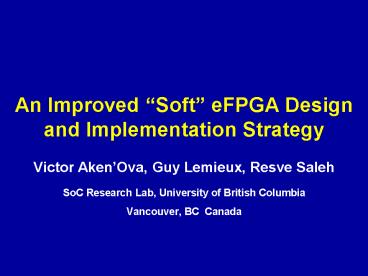An Improved Soft eFPGA Design and Implementation Strategy PowerPoint PPT Presentation
Title: An Improved Soft eFPGA Design and Implementation Strategy
1
An Improved Soft eFPGA Design and
Implementation Strategy
- Victor AkenOva, Guy Lemieux, Resve Saleh
- SoC Research Lab, University of British Columbia
- Vancouver, BC Canada
2
Overview
- Introduction and Motivation
- Embedded FPGA (eFPGA)
- Soft Embedded FPGAs
- Configurable Architecture
- Improving Soft eFPGAs
- Tactical Standard Cells
- Structured eFPGA layout
- Results
- Summary and Conclusions
3
Introduction
- SoC designs are getting more complex and costly
- Programmability can be built into SoCs to
amortize costs by reducing chip re-spins
Software Flexibility
No Flexibility
Hardware Flexibility
4
Applications for eFPGA Fabrics
An eFPGA for CPU acceleration
3
1
2
eFPGA for product differentiation
An eFPGA for revisions
5
Motivation
- shortcomings of existing eFPGA design approaches
- Hard eFPGA
- Highly efficient full-custom layouts but
inflexible - Soft eFPGA
- Very flexible but inefficient standard cell
layouts - alternative approach flexible efficient
6
Hard eFPGA Approach with a library of 3 Cores
user circuit
1
RTL
3
2
7
The Soft eFPGA Approach
eFPGA RTL Generator
ASIC flow
Generic Standard Cells
8
Some Solutions to Problems of Existing Approaches
- retain eFPGA generator idea for flexibility
But
9
Our Improved Design ApproachSoft
eFPGA RTL Generator
auto generated eFPGA
Structured ASIC FLOW
GOAL
Tactical Generic Cells
combine best of soft and hard approaches
10
Island-style eFPGA Architecture
- used island-style architecture because
- Mainstream existing FPGA CAD tools can can be
leveraged - can exploit its regular structure to improve
design efficiency - Created parameterized eFPGA in VHDL
11
Island-style eFPGA Architecture
(b) eFPGA Tile Layout
(a) Island-style eFPGA
12
Unstructured vs. Structured eFPGA Design Approach
tile1
tile2
tile3
tile4
(a) unstructured eFPGA layout
(b) structured eFPGA layout
13
Measured Impact of Structure on eFPGA Quality
- Significant improvements in logic capacity
- result of a more efficient CAD methodology
- wire-only critical path delay less by 21
- Cut CAD design time by as much as 6X
14
Architecture-specific Tactical Cells The Concept
- improve quality by creating few tactical standard
cells to replace generic cells - detailed analysis of design profile should
reveal areas that yield significant gains
15
Standard cell Area Breakdown for Island-Style
Architecture
switch 16
other 12
LUT 30
input mux 13
muxes 42
flip-flops 46
LUT mux 39
flip-flops and multiplexers dominate eFPGA area
16
Architecture-specific Tactical Cells Flip-Flop
vs. SRAM
21 area ratio!
(b) typical SRAM cell
(a) typical D flip-flop
An SRAM circuit has fewer transistors less area
17
Custom Layout of Standard Cell Flip-Flop vs.
SRAM
Standard Cell Flip-flop
Tactical SRAM Cell
18
Architecture-specific Tactical Cells CMOS vs.
Pass Gate
after extra output inverter
decompose into NAND, INV
41 area ratio!
pass tree logic uses fewer transistors and is
faster
19
Layout Technique for Pass-Tree Multiplexers
n-well
vdd
n-well
vdd
n-well cutout
gnd
gnd
extra NMOS (denser cell)
underutilized region
n-well cut-outs allow denser pass transistor tree
layouts
20
Architecture-specific Tactical Cells Cell Area
Equivalent Standard cell Area (um2)
Custom Tactical cell Area (um2)
improvement Factor
Cell
61
24
1-SRAM
2.5
899
146
6.1
161 MUX
2228
293
7.6
321 MUX
530
1875
3.5
4-LUT
3.9
1061
4180
5-LUT
21
Area Impact of Tactical Standard Cells eFPGA
Area
eFPGA
(c) full-custom
(b) soft
(a) soft
soft 2.4X smaller than soft 58 area
savings
22
Graphs of Area and Delay Savings
2.4X Better
Area
1.6 2.8X full-custom area
Benchmarks
1.4X Better
Delay
1.1X of full-custom delay
Benchmarks
23
Fabricated Chip Designs with eFPGAs (180nm
process)
(a) gradual architecture
(b) island-style architecture
24
Summary
- eFPGA area improved 58 (on average)
- 2 to 2.8X larger than full-custom equivalent
(worst case) - eFPGA delay improved 40 (average)
- within 10 of delay of full-custom versions
- exploited the regularity of island-style
architecture to increase logic capacity
25
End of Talk
26
Question and Answer Slide
Area
Logic Capacity

